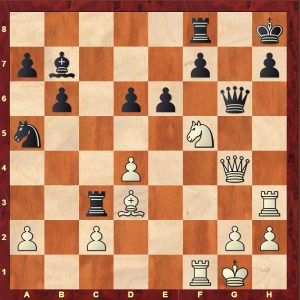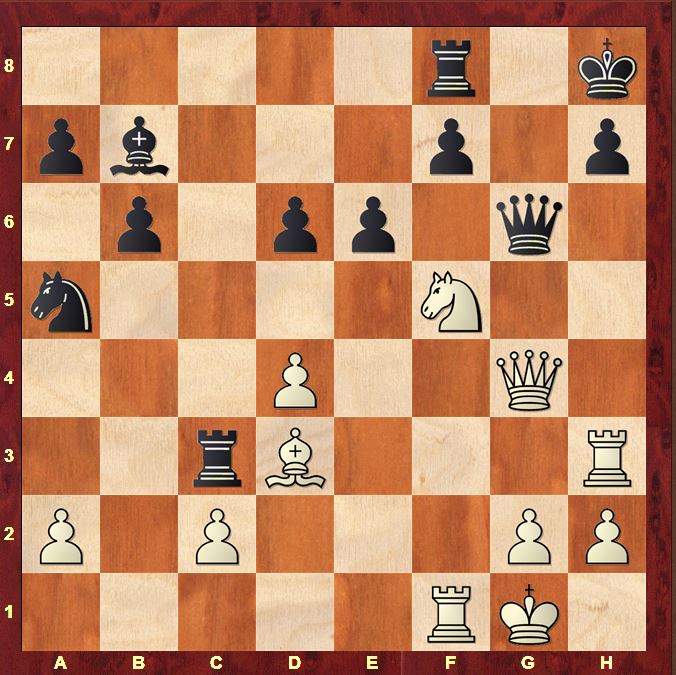We’ll warm up for this second article on Yates’ attacks with a beautiful combination, though you might argue against the rest of the game meriting an entry in a Best Games Collection!
Yates,F.D. – Colle,Edgar
Hastings 1925/6
1.e4 Nf6
Yates had a poor score with White against Colle mainly because he struggled against Colle’s Alekhine Defence, scoring 3 losses, 2 draws and this solitary (slightly fortunate) win!
2.e5 Nd5 3.Nc3 Nxc3 4.bxc3 d6 5.Nf3 g6 6.d4 Bg7 7.Bf4 0–0 8.Be2 Nc6 9.exd6 cxd6 10.Qd2 Qc7 11.0–0 b6 12.Bh6 Bb7 13.Bxg7 Kxg7 14.Nh4 Na5 15.Rae1 Rac8 16.Bd3 e6 17.Qf4 Qd8 18.Re3 Qf6 19.Qg4 Rc7 20.f4 Kh8 21.Rh3 Rxc3 22.f5
22…gxf5
22…exf5 23.Nxf5 Bc8 simply wins for Black, which wasn’t too hard to spot without either a computer or a board! The text is a huge blunder!
23.Nxf5 Qg6
23…exf5 24.Rxh7+ (24.Rxf5 Qg7 25.Rg5 wins (Winter)) 24…Kxh7 25.Rxf5 is the cleanest way 25…Qg6 26.Rxf7+

24.Ne7
1–0
A very aesthetic finish!
24.Ne7 Qxg4 25.Rxh7#
The following game was played in the first round of the London 1927 Olympiad and gave England a flying start in the tournament which culminated in a 3rd place for England behind Hungary and the surprising Danish.
Yates,F.D. – Naegeli,Oskar
London Olympiad 1927
1.e4 c5 2.Nf3 Nc6 3.d4 cxd4 4.Nxd4 Nf6 5.Nc3 d6 6.Be2 e6 7.0–0 Be7 8.Kh1 0–0 9.Be3 a6 10.f4 Qc7 11.Qe1 Bd7 12.Qg3 Rac8 13.Rad1 Rfd8 14.e5 Nd5 15.Nxd5
15.Nf5 would have won on the spot!
15…exd5
16.Nxc6
Not my favourite move, but White’s position is so good, there are a lot of strong moves
a) 16.e6 fxe6
16…Bxe6 17.Nxe6 fxe6 18.Bg4
17.Bd3 would have been my preference as the Black king is very weak. f5 and Qh3 are threats.
b) 16.f5 occupied me for a while:
16…dxe5 17.Bh6
17…g6
17…Bf8 18.Bxg7 Bxg7 19.f6
17…Bf6 18.Nxc6 Qxc6 19.Bxg7 wins
18.fxg6
18.Ne6 Bxe6 19.fxe6 f6 20.Bh5 Bf8 21.Bxg6 Bxh6 22.Rxf6 (22.Bf7+ Kh8 23.Rxf6 Bg7 24.Rg6 Rg8 25.Rg5 Ne7) 22…Qg7 23.Bxh7+ Kh8 holds for Black.
18…hxg6
18…fxg6
is the alternative. The a2-g8 diagonal is opened, but at least White doesn’t have Rxf7 ideas!
a) 19.Bh5 Qd6
b) 19.Qf2 Rf8 20.Nxc6 Bxc6 (20…Rxf2 21.Nxe7+ Kf7 22.Nxd5) 21.Bxf8 Rxf8 is a slight edge for White;
c) 19.Qf3
19…Kh8 20.Qf7 (20.Qxd5 exd4 21.Rf7 Be8 22.Bg7+ Kg8) 20…Rg8 21.Ne6 Bxe6 22.Qxe6 is a clear advantage for White
19.Bh5
19.Rxf7 Kxf7 20.Bh5 Rg8 (20…gxh5 21.Qg7+ Ke8 22.Qg6#; 20…Qd6 21.Rf1+) 21.Qf3+ (21.Rf1+ Ke8 22.Bxg6+ Kd8) 21…Bf6 22.Qxd5+ Ke7 23.Qc5+ Kf7 24.Qd5+ with a draw
19…exd4
19…Qd6 20.Rxf7 exd4 21.Rg7+ Kh8 22.Bf4 is killing for White.
20.Bf4 Qb6 21.Bxg6 is very strong for White.
16…bxc6
16…Qxc6 17.e6 fxe6
17…Bxe6 18.f5
18.Bd4 Bf8 19.Bd3 is again very dangerous for Black:
19…Qc7
19…Be8 20.Qh3
19…Re8 20.Qh4 h6 21.Qg3
20.c3 with an initiative:
20.Qh3 h6 21.Qg3 Bb5
20…Bb5 21.Bb6
The start of a double bishop sacrifice on both sides of the board!
21…Qxb6 22.Bxh7+ Kxh7 23.Qh3+ Kg8 24.Qxe6+ Kh8 25.Rf3 wins!!
17.Bd4 Bf8 18.f5 c5 19.exd6 Qxd6 20.Be5 Qc6
Loses, but so do the alternatives:
20…Qh6 21.f6 g6 (21…Qg6 22.Qxg6 hxg6 23.Bxa6) 22.Bf4
21.Bxg7
1–0
The next day was less successful. Unfortunately, as the Manchester Guardian of 19th July 1927 relates, Yates “who distinguished himself on the first day, overslept, and did not arrive in time to play”! I wonder how many other English Olympiad players in history have missed their game?
We’ll round off with another of Yates’ standard Sicilian attacks!
Yates,F.D. – Takacs,Sandor
Kecskemet-S2 Kecskemet (1), 1927
1.e4 c5 2.Nf3 Nc6 3.d4 cxd4 4.Nxd4 Nf6 5.Nc3 d6 6.Be2 e6 7.0–0 Be7 8.Kh1 a6 9.Be3 Qc7 10.f4 Bd7 11.Qe1 b5 12.a3 0–0 13.Rd1 Na5 14.Qg3
As we saw in the previous game, this was Yates’ favourite way of playing against the Sicilian: bishop on e3 holding the knight on d4 (no Nb3 as was common at the time) pawn on f4, queen around to g3 and a quick e4–e5.
14…Nc4 15.Bc1 Rfc8 16.b3 Nxa3 17.e5 Ne8 18.Ne4 d5 19.Nf6+ Kh8
20.Qh4
a) 20.Nxd7 Qxd7 21.Bd3 was my simple route to an advantage (21.f5 Nxc2 22.fxe6 fxe6 23.Nxc2 Rxc2 24.Bd3 Rc3 25.Rf7 Also looked incredibly strong for White and Stockfish confirms) 21…f5 22.exf6 Nxf6 23.Qh3 is very good for White
b) 20.Nxh7 was my more complicated attempt!
20…Kxh7
20…Nxc2 21.Qh3 Kg8 22.Nxc2 (22.Bd3 Nxd4 23.Nf6+ Nxf6 24.exf6 looked decisive to me but… 24…g6 (24…Bxf6 25.Qh7+ Kf8 26.Ba3+) 25.fxe7 Qc3 still sort of holds for Black) 22…Qxc2 23.Bd3 Qc7 24.Ng5
21.Bd3+ Kg8
21…g6 22.Nxe6
22…Bxe6 (22…Qc6 23.f5) 23.f5 Bxf5 24.Rxf5
22.f5 exf5 23.Nxf5 Bxf5 24.Rxf5 Nxc2 (24…Qc6 25.Rdf1) 25.Rh5
looked winning to me and Stockfish agrees
20…Nxf6 21.Bd3 g6
21…h6 22.Bxa3 Bxa3 23.exf6 Qd8 offers Black defensive chances though his position is still fraught after 24.fxg7+ Kxg7 25.Qg3+ Kh8 26.f5
22.exf6 Bf8 23.Nf3 Kg8
24.Ng5
24.Bxa3 Bxa3 25.Ng5 h5 26.Nxf7 Kxf7 27.Bxg6+ is another easy win as pointed out by WInter
24…h6 25.Bxa3 hxg5
26.fxg5
26.Qxg5 Bxa3 27.Bxg6 Kf8 28.Bxf7 is another easy win
26…Bxa3 27.Bxg6
Yates is starting to overcook things!
27.b4 was my line, and works very well. In comparison to the game, Black has fewer defensive possibilities. For example,
27…Rf8 just loses to 28.Qh6
27…Bxb4 (27…Qd6 28.Bxg6 fxg6 29.Qh6 Kf7 30.Qg7+ Ke8 31.f7+ Kd8 32.f8Q+ wins) 28.Qxb4 Qc5 29.Qh4 e5 30.Bxg6 fxg6 31.Qh6 Kf7 32.Rxd5
Stockfish’s finishing blow!
27…fxg6 28.Rd3
28…Rf8
a) 28...e5 29.f7+
29.Qh6 Bf5 (29…Be6 30.Qxg6+ Kf8 31.Qh5 I was pleased to spot this move. White’s queen retreats preventing the escape of Black’s king by covering the e8 square and threatening both Qh8+ and g6; 29…Be8 30.Rh3 Kf7 31.Qg7+ Ke6 32.f7) 30.Rxf5 Qh7 Stockfish – I’d missed this idea!
29…Kf8 30.Qh8+ Ke7 31.Qf6+ Kf8 32.Rxd5
Stockfish – I hadn’t spotted the idea of playing Rxe5 and Qh8+
32…Qc6 33.Qh8+ Ke7 34.Qxe5+ Qe6 35.Qg7 Kd8 36.f8Q+ Bxf8 37.Rxd7+ Qxd7 38.Rxf8+ Kc7 39.Rf7 is winning for White according to Stockfish
b) 28…Qxc2 is the best defence according to Stockfish
29.Rh3 Kf7
The queen on c2 covers g6!
30.Qh7+ Ke8 31.Qg8+ Bf8 32.Rh7 Qc6 33.Re7+ Kd8 34.Qxf8+ Kc7 is pretty good for Black
29.b4 Bxb4
A blunder
29…Qd6 30.Rh3 Kf7 31.Qh7+ Ke8 escapes with the king. The position is very unclear after 32.Qxg6+ Kd8 33.Rxa3
30.Rh3
1–0
As a final aside, I analysed Yates’ games at the same time as I was working my way through Alekhine’s Best Games collection. The comparison only increased my respect for the quality of Alekhine’s play and the depth of his analysis. 80 years later, with the support of strong engines, I’m still ecstatic if I find a mistake in Alekhine’s conceptions; by contrast, I could pick out most of the mistakes in Yates’ play and analysis while reading his book without sight of the board. It’s an amazing testament to the difference between a leading player of the 1920’s and that incomparable genius Alekhine.



